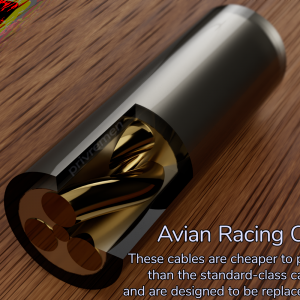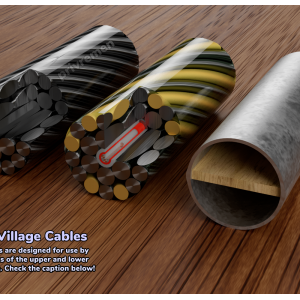Navigation
Install the app
How to install the app on iOS
Follow along with the video below to see how to install our site as a web app on your home screen.

Note: This feature currently requires accessing the site using the built-in Safari browser.
More options
You are using an out of date browser. It may not display this or other websites correctly.
You should upgrade or use an alternative browser.
You should upgrade or use an alternative browser.
Media information
Caption
To the left is a standard-issue cable used by the people of the upper and lower avian villages. This particular sample is shown without any purposefully sharpened wires or sharp spikes along the bottom. Such spikes are used as a deterrent against people climbing on them directly, but their main use is to keep outsiders from accessing restricted cableways. Most standard civilian cableways do not feature spikes or defensive measures on them, however. The cable features seven large cables on the inside, with fifteen smaller cables wrapped around them tightly. This is a particularly new sample of cable, since it's lubricating lacquer is still thickly applied. Older cableways, along with commonly traveled cableways in areas such as homes and markets, tend to have much less of this material on them, and their appearance is certainly not as smooth as this sample.
In the center is an experimental cable designed to carry an electrical signal along a cableway, featuring three wires surrounded by heavy insulation to ensure longevity. These cables, if proven to be safe for long-term use, could reduce the amount of external power that needs to be drawn in to the avian villages. Instead of routing electrical wires along the floor or underground, these electrical riding cables can be used to both provide transportation and power in one neat package, thus cleaning up the wires behind stalls. The cable has six solid brass lines in it to both act as an indicator of damage and to reduce sparking, since the electrical wires inside could pose a problem if they're ever revealed to the elements. To distinguish this cable from others, the sealant has been dyed green.
To the right is a dangerous trapped cable, simply being a long but thin plank of wood surrounded in a thin circular jacket of a soft metal - usually lead or some alloy of lead - which immediately flexes and snaps as soon as a cable rider is affixed and weight is applied. These were used long ago by a few residents protecting their smaller claims of land outside of the village, but they're now outlawed by both the upper and lower villages for obvious reasons. It's still possible to find old lines that were never tripped or taken down, so caution must be taken when riding lines that don't look right.
In the center is an experimental cable designed to carry an electrical signal along a cableway, featuring three wires surrounded by heavy insulation to ensure longevity. These cables, if proven to be safe for long-term use, could reduce the amount of external power that needs to be drawn in to the avian villages. Instead of routing electrical wires along the floor or underground, these electrical riding cables can be used to both provide transportation and power in one neat package, thus cleaning up the wires behind stalls. The cable has six solid brass lines in it to both act as an indicator of damage and to reduce sparking, since the electrical wires inside could pose a problem if they're ever revealed to the elements. To distinguish this cable from others, the sealant has been dyed green.
To the right is a dangerous trapped cable, simply being a long but thin plank of wood surrounded in a thin circular jacket of a soft metal - usually lead or some alloy of lead - which immediately flexes and snaps as soon as a cable rider is affixed and weight is applied. These were used long ago by a few residents protecting their smaller claims of land outside of the village, but they're now outlawed by both the upper and lower villages for obvious reasons. It's still possible to find old lines that were never tripped or taken down, so caution must be taken when riding lines that don't look right.




